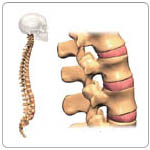What is a herniated disc?
The bones (vertebrae) that form the spine in your back are cushioned by small discs. These discs are round and flat, with a tough, outer shell (capsule or annulus) that surrounds a jellylike material, called the nucleus.
 When these discs are healthy, they act as shock absorbers for the spine and keep the spine flexible. The normal, everyday pressure on the disc forces its outer surface to bulge slightly. When these discs are damaged from an injury, normal wear and tear, or disease, they may bulge abnormally or break open (rupture). When a disc bulges abnormally or ruptures, it is called a herniated disc. It may also be called a slipped or ruptured disc.
When these discs are healthy, they act as shock absorbers for the spine and keep the spine flexible. The normal, everyday pressure on the disc forces its outer surface to bulge slightly. When these discs are damaged from an injury, normal wear and tear, or disease, they may bulge abnormally or break open (rupture). When a disc bulges abnormally or ruptures, it is called a herniated disc. It may also be called a slipped or ruptured disc.
Herniated discs can occur in any part of the spine. Most herniated discs affect the lower back (lumbar spine).
Some occur in the neck (cervical spine) and, more rarely, in the upper back (thoracic spine). This topic focuses mainly on the lower back (lumbar) area.
What causes a herniated disc?
A herniated disc usually is caused by wear and tear of the disc (also called disc degeneration). As we age, our discs lose some of the fluid that helps them maintain flexibility. A herniated disc also may result from injuries to the spine, which may cause tiny tears or cracks in the outer layer (annulus or capsule) of the disc. The jellylike material inside the disc (nucleus) may be forced out through the tears or cracks in the capsule, which causes the disc to bulge, break open (rupture), or break into fragments.
What are the symptoms?
Although injury to the outer covering (capsule or annulus) of a disc can cause pain, often a herniated disc does not cause any pain. Pain occurs when the membrane on the outside of the spinal cord or spinal nerves is irritated. Loss of function-such as weakness or altered sensation-can be caused by pressure from the herniated disc on the nerve roots. Pain or numbness may occur in the area of the body to which the nerve travels. For example, a herniated disc that presses on one of the nerve roots of the sciatic nerve-a large nerve that extends from the lower back down the back of the leg-may cause pain and numbness in the leg, a condition called sciatica. Sciatica is the most common symptom of a herniated disc in the lower back.
You may also develop back pain along with a herniated disc and sciatica. Like sciatica, this associated back pain usually subsides over time.
Most back and neck pain is not caused by a herniated disc. Nerve problems caused by a herniated disc account for about 4% of low back pain.
How is a herniated disc diagnosed?
A health professional can often diagnose a herniated disc using a medical history and physical examination. If your symptoms are clearly caused by a herniated disc, you probably will not need additional tests during your first medical visit. Sometimes additional imaging tests, such as magnetic resonance image (MRI) or computed tomography (CT) scan, are used to confirm a diagnosis.
How is it treated?
Most herniated discs heal without surgery after a few weeks or months of nonsurgical treatment, which may include a short period of rest, medication for pain relief, and an exercise program prescribed by a health professional. About 50% of people with a herniated disc recover within 1 month; after 6 months, most recover. Your health professional may recommend corticosteroid injections in the area of the disc herniation to relieve symptoms and nerve irritation. Only 10% of people with herniated disc problems that cause noticeable symptoms have enough pain after 6 weeks to consider surgery.
Advanced Reproductive Technology
- In Vitro Fertilisation (IVF)
- Intracytoplasmic Sperm Injection (ICSI)
- Donor egg and embryo programs
- In Vitro Fertilisation (IVF)
- Pre-implantation genetic diagnosis (PGD)
- Surrogacy programs
Dental Videos





